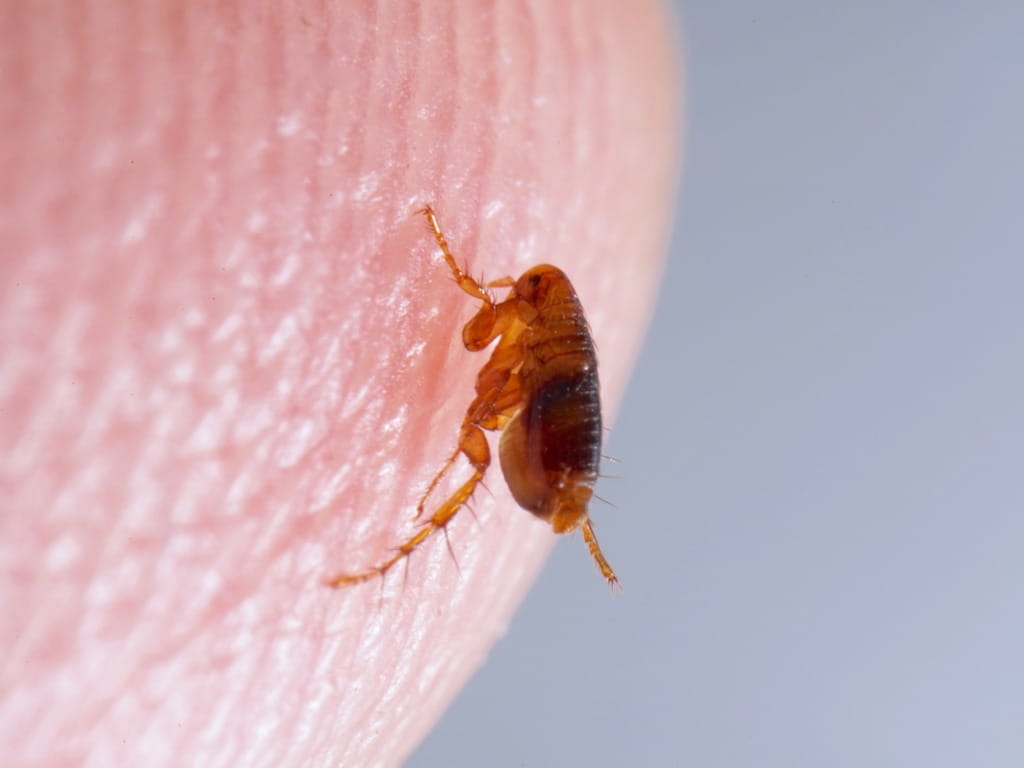Is Flea Medication Poisonous to Humans?

The Bottom Line
Lufenuron is used to control fleas on dogs and cats. It is not used in humans, but humans might accidentally take an animal’s medication or come into contact with it in the form of an agricultural spray. Minor side effects such as GI upset and drowsiness might occur if that happens. No human overdoses have been published.

The Full Story
Fleas are small (up to 1/8 inch), blood-sucking insects. They live on warm-blooded animals such as dogs and cats. Not only do they cause irritating, itchy bites, they also are capable of transmitting diseases and parasites such as typhus, plague, and some tapeworms. A heavy infestation of fleas can cause iron deficiency anemia due to blood loss, particularly in young animals. When a dog or cat becomes infested with fleas, pet owners need to thoroughly clean all bedding, rugs, floors, and carpets as well as treat all animals in the home. A good bath and flea comb are important tools to remove fleas and their eggs from fur. A veterinarian can recommend a medication to control fleas after this. The egg, larval, and adult stages of fleas must all be killed for flea control to be successful.
How Does Lufenuron Control Fleas?
Lufenuron is a benzoylphenyl urea pesticide found in the veterinary flea control medication Program® for dogs and cats. It is also sold in combination with antiparasitic (deworming) agents in Sentinel® or Spectrum® for dogs. These products are not given to humans. Lufenuron is administered to dogs as a chewable tablet given monthly with food. Cats may receive lufenuron by twice-yearly injection or as monthly oral tablets or liquid. It is considered safe for pregnant and nursing pets as well as puppies at least 4 weeks and kittens at least 6 weeks of age.
Lufenuron is stored in the animal’s body fat and slowly released into the blood. When an adult flea feeds, it ingests lufenuron along with the animal’s blood. Lufenuron does not harm adult fleas but is passed on to the eggs and larvae, where it inhibits growth and development by blocking the synthesis of chitin, which is required for egg hatching and larval development. Chitin is necessary for the hard outer shell (exoskeleton) that protects insects from dehydration. In this way, lufenuron prevents flea eggs from hatching and flea larvae from maturing into adults, so the life cycle is broken. It works best when given with a second product that kills adult fleas. The adult flea-killing product might be a spot-on treatment or an oral medication like nitenpyram (Capstar®). Flea control regimens must be repeated every year during flea season.
What are Lufenuron’s Adverse Effects and Toxicity?
According to the World Health Organization (WHO), lufenuron is safe to give to mammals like dogs and cats because it is not acted on by the liver or kidneys. It is gradually filtered from the blood and excreted intact from the body with a half-life of about 60 days. Also, because lufenuron acts by blocking chitin synthesis, mammals are unaffected since they lack chitin. The manufacturer of lufenuron states that it very rarely (less than 5 animals in a million doses) might cause temporary side effects such as gastrointestinal upset (vomiting, diarrhea, lack of appetite) and fatigue. Lufenuron is not known to interact with other medications.
Unintentional human exposures to lufenuron are sometimes reported (see “This Really Happened”), but no intentional human overdoses have been published. Humans might be exposed to lufenuron by accidentally taking a pet’s medication or using an agricultural product that contains the chemical. The latter might happen to workers spraying lufenuron to control pests in greenhouses or grain storage facilities.
Lufenuron has a wide margin of safety in mammals due to its mechanism of action. Human exposures are rare and can generally be managed at home with observation for symptoms such as GI upset and drowsiness. If someone accidentally takes a pet’s medication containing extra ingredients such as adult flea killers or dewormers, the side effects of those agents might occur.
If you suspect someone has unintentionally taken lufenuron, get an immediate personalized recommendation online or call Poison Control at 1-800-222-1222. Both options are free, confidential, and available 24 hours a day.
Leslie A. McCament-Mann, PhD, RPh
Clinical Toxicologist
Poisoned?
Call 1-800-222-1222 or
Prevention Tips
- When a dog or cat is found to be carrying fleas, follow a veterinarian’s advice for cleaning the house and treating all animals. Repeat flea treatments yearly.
- Do not give flea treatments to humans.
- Keep pet medications in a separate location from human medications, and do not set out a dog or cat’s tablet where a person might accidentally take it.
- Keep all medications and dietary supplements in child-resistant packaging and stored away from children and pets.
This Really Happened
Case 1. Researchers compiled data on adverse effects from a series of 57 unintentional ingestions involving lufenuron (1–26.4 mg/kg) in people aged 8 months to 65 years (51% were >5 years). Their findings were:
- One episode of vomiting within 2 hours of ingestion by a 15-month-old boy.
- Diarrhea in a 13-year-old girl that resolved within 8 hours.
- Nausea and diarrhea occurring 24 hours after ingestion by a 53-year-old woman (unknown if related to lufenuron due to the delay in onset of symptoms).
The authors concluded that lufenuron did not cause any significant toxicity in the human cases they studied (Herrington & Herrick, 1998).
Case 2. A 51-year-old woman called Poison Control after unintentionally swallowing her dog’s Sentinel tablet (lufenuron plus milbemycin oxime). The woman was advised that the tablet was not likely to cause any significant toxicity, but that human data are very limited with lufenuron and milbemycin oxime. Poison Control instructed her to watch for symptoms like nausea and vomiting, diarrhea, drowsiness, and headache. When Poison Control contacted her about 6 hours later, she reported no symptoms from the exposure.
For More Information
Gollakner R. Lufenuron. Los Angeles: VCA Animal Hospitals [cited 2022 Feb 17].
References
Herrington LF, Herrick ME. Human exposures to Program (lufenuron) [abstract]. J Toxicol Clin Toxicol. 1998;36(5):491.
Plumb DC. Plumb's veterinary drug handbook. 9th ed. Stockholm (WI): Pharma Vet; 2018.
Poisoned?
Call 1-800-222-1222 or
Prevention Tips
- When a dog or cat is found to be carrying fleas, follow a veterinarian’s advice for cleaning the house and treating all animals. Repeat flea treatments yearly.
- Do not give flea treatments to humans.
- Keep pet medications in a separate location from human medications, and do not set out a dog or cat’s tablet where a person might accidentally take it.
- Keep all medications and dietary supplements in child-resistant packaging and stored away from children and pets.
This Really Happened
Case 1. Researchers compiled data on adverse effects from a series of 57 unintentional ingestions involving lufenuron (1–26.4 mg/kg) in people aged 8 months to 65 years (51% were >5 years). Their findings were:
- One episode of vomiting within 2 hours of ingestion by a 15-month-old boy.
- Diarrhea in a 13-year-old girl that resolved within 8 hours.
- Nausea and diarrhea occurring 24 hours after ingestion by a 53-year-old woman (unknown if related to lufenuron due to the delay in onset of symptoms).
The authors concluded that lufenuron did not cause any significant toxicity in the human cases they studied (Herrington & Herrick, 1998).
Case 2. A 51-year-old woman called Poison Control after unintentionally swallowing her dog’s Sentinel tablet (lufenuron plus milbemycin oxime). The woman was advised that the tablet was not likely to cause any significant toxicity, but that human data are very limited with lufenuron and milbemycin oxime. Poison Control instructed her to watch for symptoms like nausea and vomiting, diarrhea, drowsiness, and headache. When Poison Control contacted her about 6 hours later, she reported no symptoms from the exposure.
